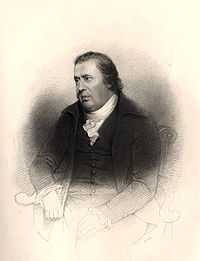William Smellie (encyclopedist)
| William Smellie FRSE, FSA (Scot) | |
|---|---|
|
William Smellie, by Henry Bryan Hall | |
| Born |
1740 The Pleasance, Edinburgh |
| Died |
24 June 1795 Edinburgh |
Resting place |
Greyfriars Kirkyard, Edinburgh 55°56′48″N 3°11′32″W / 55.94667°N 3.19222°W |
| Residence | Edinburgh |
| Nationality | Scottish |
| Education |
Duddingston parish school High School, Edinburgh |
| Alma mater | Edinburgh University |
| Occupation | Printer, editor, naturalist, antiquary |
| Employer |
Apprentice, Hamilton, Balfour & Neil, printers, 1752 Edited 1st Edition of the Encyclopædia Britannica, 1771- Editor, Edinburgh Magazine & Review, 1773-6 Partner with William Creech, ; 1782- |
| Known for | Editor of the 1st Edition of the Encyclopædia Britannica |
| Spouse(s) | Jean Robertson (m 1763) |
| Parent(s) | Alexander Smellie, architect, Edinburgh |
|
Notes Member of the Edinburgh Philosophical Society, thereby becoming a founding fellow of the Royal Society of Edinburgh upon the Philosophical Society receiving its royal charter in 1783 Founder of the Newtonian Club (1760) | |
William Smellie FRSE FSA (Scot) (1740–1795) was a Scottish master printer, naturalist, antiquary, editor and encyclopedist.[1] He was friends with Robert Burns, whose assessment is engraved on Smellie's tombstone: "Here lies a man who did honour to human nature".[2] Burns also described him fondly in a letter as "that old Veteran in Genius, Wit and Bawdry".[3]
Encyclopædia Britannica
At the age of 28, Smellie was hired by Colin Macfarquhar and Andrew Bell to edit the first edition of the Encyclopædia Britannica, which appeared in 100 weekly instalments ("numbers") from December 1768 to 1771. It was a masterful composition although, by his own admission,[2] Smellie borrowed liberally from many authors of his day, such as Voltaire, Benjamin Franklin, Alexander Pope and Samuel Johnson.[4] Nevertheless, the first edition of the Britannica contained gross inaccuracies and fanciful speculations; for example, it states that excess use of tobacco could cause neurodegeneration, "drying up the brain to a little black lump consisting of mere membranes".[5] Smellie strove to make Britannica as usable as possible, saying that "utility ought to be the principal intention of every publication. Wherever this intention does not plainly appear, neither the books nor their authors have the smallest claim to the approbation of mankind". Smellie entertained strong opinions; for example, he defines farriery as "the art of curing the diseases of horses. The practice of this useful art has been hitherto almost entirely confined to a set of men who are totally ignorant of anatomy, and the general principles of medicine."[6] Although possessed of wide knowledge, Smellie was not an expert in all matters; for example, his article on "Woman" has but four words: "the female of man."[6] Despite its incompleteness and inaccuracies, Smellie's vivid prose and the easy navigation of the first edition led to strong demand for a second;[7] some prurient engravings by Andrew Bell (later censored by King George III) may also have contributed to the success of the first edition.[2] Smellie did not participate in the second edition of the Britannica, because he objected to the inclusion of biographical articles in an encyclopedia dedicated to the arts and sciences.
Other work
At the time of his hiring, Smellie edited a weekly called the Scot's Journal, which made him familiar with the editing and publication of a work in parts.[8]
Smellie is also noted for his English translation of the famous Histoire Naturelle of the French naturalist Georges-Louis Leclerc, Comte de Buffon.
In 1779, Smellie was nominated to be the University of Edinburgh's Professor of Natural History; however, the post was awarded to Dr. John Walker, allegedly due to politics.
Smellie continued to publish a wide variety of works, including his two-volume Philosophy of Natural History, which became a set text at Harvard University in the nineteenth century, and at least two of the four-volume set of Thesaurus medicus: sive, disputationum, in Academia Edinensi, ad rem medicam pertinentium, a collegio instituto ad hoc usque tempus, delectu which reprinted Edinburgh medical theses of the 18th century.
Smellie was the son of a master builder and stonemason. He was educated at the Royal High School, Edinburgh. At the age of 12, he was apprenticed to a printer; he rose to the rank of master printer.
He is buried in Greyfriars Kirkyard just north of the Adam Mausoleum, southwest of the church.
See also
References
| Wikisource has original works written by or about: William Smellie |
- ↑ Waterston, Charles D; Macmillan Shearer, A (July 2006). Former Fellows of the Royal Society of Edinburgh 1783-2002: Biographical Index II. Edinburgh: The Royal Society of Edinburgh. ISBN 9780902198845. Retrieved 17 November 2011.
- ↑ 2.0 2.1 2.2 Banquet at Guildhall in the City of London, Tuesday 15 October 1968: Celebrating the 200th Anniversary of the Encyclopædia Britannica and the 25th Anniversary of the Honorable William Benton as its Chairman and Publisher. Encyclopædia Britannica International, Ltd. 1968.
- ↑ J. De Lancey Fergusson and G. Ross Roy, ed. (1985). The Letters of Robert Burns. Volume II of II. Oxford: Clarendon Press. p. 10. ISBN 0-19-812321-3.
- ↑ Kister, KF (1994). Kister's Best Encyclopedias: A Comparative Guide to General and Specialized Encyclopedias (2nd ed. ed.). Phoenix, AZ: Oryx Press. ISBN 0-89774-744-5.
- ↑ Krapp, Philip; Balou, Patricia K. (1992). Collier's Encyclopedia 9. New York: Macmillan Educational Company. p. 135. Library of Congress catalog number 91-61165.
- ↑ 6.0 6.1 "Encyclopedias". Encyclopædia Britannica (1st edition ed.). 1771.
- ↑ "Encyclopedias". Encyclopædia Britannica (14th edition ed.). 1954.
- ↑ Wells, James M. (1968). The Circle of Knowledge: Encyclopaedias Past and Present. Chicago: The Newberry Library. Library of Congress catalog number 68-21708.
|
